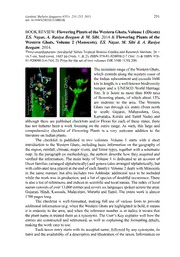
Flowering Plants of the Western Ghats, Volume 1 (Dicots) T.S. Nayar, A. Rasiya Beegam & M. Sibi. 2014 & Flowering Plants of the Western Ghats, Volume 2 (Monocots). T.S. Nayar, M. Sibi & A. Rasiya Beegam. 2014 PDF
Preview Flowering Plants of the Western Ghats, Volume 1 (Dicots) T.S. Nayar, A. Rasiya Beegam & M. Sibi. 2014 & Flowering Plants of the Western Ghats, Volume 2 (Monocots). T.S. Nayar, M. Sibi & A. Rasiya Beegam. 2014
Gardens’Bulletin Singapore 67(1): 251-252. 2015 251 doi: 10.3850/S2382581215000198 BOOK REVIEW: Flowering Plants ofthe Western Ghats, Volume 1 (Dicots) T,S, NayaVy A. Rasiya Beegam & M. Sibi. 2014 & Flowering Plants of the Western Ghats, Volume 2 (Monocots). T.S. NayaVy M, Sibi & A, Rasiya Beegam. 2014. Thimvananthapuram: Jawaharlal Nehru Tropical Botanic Garden and Research Institute. 26 x 16.5 cm, hard cover, 1683 pp (Vols. 1. & 2). ISBN 978-81-920098-2-7 (Vol. 1) & ISBN 978- 81-920098-3-4 (Vol. 2). Price for the set oftwo volumes INR 3500 / US$ 200. The mountain range ofthe Western Ghats, whieh extends along the western coast of the Indian subcontinent and exceeds 1600 km in length, is a well-known biodiversity UNESCO hotspot and a World Heritage Site. It is home to more than 8000 taxa of flowering plants, of which about 15% are endemic to the area. The Western Ghats run through six states (from north to south: Gujarat, Maharashtra, Goa, Karnataka, Kerala and Tamil Nadu) and although there are published checklists and/or Floras for each of these states, there has not hitherto been a work focusing on the entire range. As such, this large and comprehensive checklist of Flowering Plants is a very welcome addition to the literature on Indian plants. The checklist is published in two volumes. Volume 1 starts with a short introduction to the Western Ghats, including basic information on the geography of the region, rainfall, climate, major rivers, and forest types, together with a schematic map. In the paragraph on methodology, the authors describe how they acquired and verifled the information. The main body of Volume 1 is dedicated to an account of Dicot families (arranged alphabetically) and genera (also arranged alphabetically, but with cultivated taxa placed at the end of each family). Volume 2 deals with Monocots in the same manner, but also includes two Addenda: additional taxa to be included while the work was in production, and a list of species of doubtful occurrence. There is also a list ofreferences, and indices to scientiflc and local names. The index oflocal names consists ofover 13,000 entries and covers six languages spoken across the area: Gujarati, Hindi, Kannada, Malayalam, Marathi and Tamil. The entire work is almost 1700 pages long. The checklist is well-formatted, making full use of various fonts to provide additional information (e.g. when the Western Ghats are highlighted in bold, it means it is endemic to the area; and when the reference number is in italics it means that the plant name is treated there as a synonym). The User’s Key explains well how the entries are constructed and referenced, as well as explaining the formatting details, making the work easy to use. Each taxon entry starts with its accepted name, followed by any synonyms, its habit and the availability ofa description and illustration ofthe taxon. Information on 252 Card. Bull. Singapore 67(1) 2015 its complete native distribution is followed by its distribution and phenology within the Western Ghats. These are followed by the threat category, economic importance and a list of local names. Considering that this is just a checklist, it is surprisingly well referenced. The list ofreferences contains full citations to 2936 numbered works with these numbers referenced in each entry to justify the information provided and to allow the reader to follow up on details ifneeded. A random check on families with which I am familiar shows that the authors have strived to gather the latest literature to ensure that the names used are indeed, in the vast majority of cases, up-to-date. However, I did spot some unusual placements of genera, e.g. Cheilocostus and Costus of the family Costacaeae are placed in the Zingiberaceae. The family Costaceae has been unambiguously recognised for at least the last 50 years and has been reflected in all major recent works and databases, including those used by the authors for verifications, so their family concept comes as a bit of a surprise. As a potential end user I regret that such a work as this, during an era of rapid botanical exploration and publication, will inevitably become outdated in a few years, and was not rather designed as an online project. Not only would that have allowed various targeted searches to be performed, but the authors could also more dynamically keep the data updated and respond to feedback. It may also perhaps have formed the kernel of an expansion of the project into fully-fledged Flora of the Western Ghats, which could also be illustrated. It would be lovely to see ferns and gymnosperms also included. Considering the extent ofthis work, the authors must no doubt be congratulated on the final product, which must have required much perseverance and the ability to cope with extremely large numbers ofnames, synonyms and references. V Jana Leong-Skornickova Singapore Botanic Gardens
